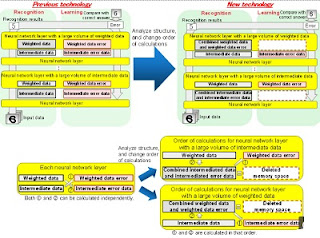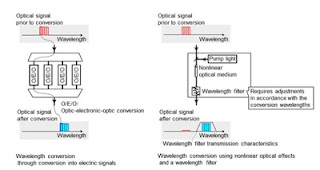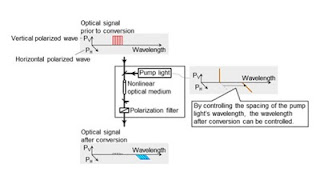Fraunhofer HHI Develop First-Ever Simultaneous Wavelength Conversion Technology
with No Wavelength Restriction in Next-Generation Optical Networks
wavelength-division-multiplexed signal in excess of 1 Tbps
 |
| Figure 1. Wavelength contention at optical relay nodes |
 |
| Figure 2. Examples of wavelength conversion technologies |
 |
| Figure 3. The proposed wavelength conversion technology |
Laboratories Ltd. and the Fraunhofer Heinrich Hertz Institute HHI today
announced the development of a new method to simultaneously convert the
wavelengths of wavelength-division-multiplexed signals necessary for optical
communication relay nodes in future wavelength-division-multiplexed optical
networks, and have successfully tested the method using high-bandwidth signal
transmission in the range of 1 Tbps.
In the conventional optical wavelength conversion
method each individual optical wavelength is converted into an electrical
signal and re-transmitted at a new wavelength, which is impractical for
terabit-class processing as each wavelength requires its own O/E/O circuit.
Using the new technology, the optical wavelength conversion and the
polarization state are controlled at the same time, so simultaneous wavelength
conversion of wide-band optical signals can be achieved without restrictions on
the wavelengths of the optical input signal or the modulation formats. As a
result, processing can be achieved with a single wavelength converter,
regardless of the number of wavelengths multiplexed. Therefore, considering
optical signals in excess of 1 Tbps multiplexed from ten wavelengths, for
example, the new method can process them using just one-tenth of the power or
less compared to previous technologies that required a separate circuit to
convert each wavelength into an electrical signal and back.
By applying this technology to the optical nodes
within the optical network, the usage efficiency of the communications band is
improved, and this is expected to contribute to a more stable communications
environment.
Details of this technology will be announced at
ECOC 2016 (42nd European Conference on Optical Communication), an international
conference that will be held from Sunday, September 18 to Thursday,
September 22 in Dusseldorf, Germany.
Background
Today, optical fiber networks which support
large-scale datacenters and sophisticated cloud-based ICT services rely on
wavelength-division-multiplexing (WDM) technology, which combines optical
signals of different wavelengths for transmission in a single optical fiber to
connect multiple terminals in an optical network with high bandwidth and low
latency. In recent years, the bandwidth achieved per wavelength typically is
100 Gbps with the polarization-multiplexed quadrature phase shift keying
modulation method(1). Progress is now being made on developing technology that,
by increasing the modulation multiplicity, will make it possible to achieve
terabit-class high-bandwidth communications environments in the future.
Technological Issues
When connecting multiple terminals in an optical
network, it is necessary to avoid collisions/contention (figure 1) by having
the ability to convert between wavelengths because optical signals of the same
wavelength cannot be transmitted in the same optical fiber between the optical
relay nodes.
Previously, two methods were proposed: A method
for momentary conversion into an electrical signal (left side of figure 2), and
a method using nonlinear optical effects and a wavelength filter (right side of
figure 2). With the first method, however, there was an issue due to the
increase in processing latency from the mutual conversion of electrical and
optical signals. Another issue was that because one conversion circuit is
required for each wavelength, an increase in the number of multiplexed
wavelengths increases the amount of consumed electricity. Likewise, with the
latter method, although it enables wavelengths to be converted in one batch,
the practical implementation is problematic because it requires a filter
element to remove just the wavelengths of the signal prior to conversion,
making it difficult to handle signals with a variety of wavelengths.
The Newly Developed Technology
Now Fujitsu Laboratories and Fraunhofer HHI have
discovered a new simultaneous wavelength conversion method that controls the
optical wavelength conversion and the polarization state at once, and have
created a prototype wavelength conversion circuit based on this principle.
Using this prototype circuit, they succeeded in an experiment to simultaneously
convert optical polarization division multiplexed optical signals exceeding 1
Tbps. This represents the world’s first successful implementation of a
simultaneous wavelength conversion capability that functions without any
restrictions on the wavelength of the optical signals input or the modulation
format.
The newly developed technology has the following
features.
1. A world’s first: New simultaneous wavelength
conversion technology using a polarization filter
It is known that by combining an optical signal
comprised of multiple wavelengths with pump light when inputting into a
nonlinear optical medium, it is possible to generate a wavelength converted
light that is still mixed with the input optical signal. Fujitsu Laboratories
and Fraunhofer HHI developed a new simultaneous wavelength conversion
technology that, in accordance with the wavelength conversion, alters the
polarization state of the optical signal, and, using a polarization filter
instead of the wavelength filter used in previous technologies, removes the
optical signal prior to the wavelength conversion. It then extracts just the
optical signal after the wavelength conversion. By controlling the spacing of
the pump light’s wavelength, the wavelength after conversion can be controlled
at the user’s discretion.
2. Simultaneous wavelength conversion technology
for polarization-multiplexed optical signals
The two components of the optical signal consist
of the vertically polarized wave and the horizontally polarized wave. By
separating them, performing the wavelength conversion in parallel, and then
recombining the signal, Fujitsu Laboratories and Fraunhofer HHI developed a
technology for polarization-multiplexed signals. Using a prototype circuit
based on this principle, they achieved simultaneous conversion of
polarization-multiplexed signals exceeding 1 Tbps.
Effects
Whereas, previously, for the wavelength
conversion of high-bandwidth optical signal of 1 Tbps, for example, 10
converters were required for conversion into electrical signals, simultaneous
conversion using just one converter is possible using the new technology. This
enables to achieve the equivalent function while consuming one-tenth the power
or less than previously required. In addition, because there are no
restrictions on the wavelengths before or after conversion, this technology
will contribute to the creation of next-generation optical networks in which
the configuration of the network can be flexibly modified.
Future Plans
Targeting practical implementation around 2020,
Fujitsu Laboratories and Fraunhofer HHI will work on further improvements in
conversion efficiency as well as improvements in the feasibility of volume
production that are needed for commercialization of this technology.
(1) Polarization-multiplexed quadrature phase
shift keying modulation method
An optical modulation method that has become the
de facto industry standard for 100 Gbps optical transmission systems. It
combines quadrature phase modulation with polarization-multiplexing technology,
in which the vertically polarized wave and the horizontally polarized wave of
the optical signal are multiplexed to double the transmission capacity.
For the LATEST tech updates,
FOLLOW us on our Twitter
LIKE us on our FaceBook
SUBSCRIBE to us on our YouTube Channel!





